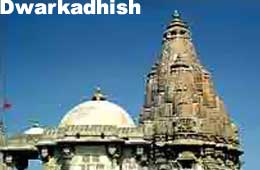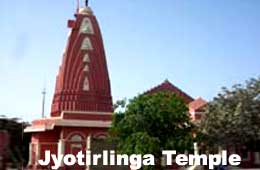| India Profile » Monuments and Temples in India » Discovering Ancient Secrets | |
Discovering Ancient Secrets, Dwarka | |
 | |
 Dwarka is an important city for Hindu Pilgrimage. It was the fabled capital city of Lord Krishna. The land for the city was reclaimed from the sea near the western shores of Saurashtra. Dwarka was a planned city built on the banks of river Gomati. The beautiful city was also known by various other names like Dwaramati, Dwarawati and Kushsthali. The city was divided into well-organized six different sectors, residential and commercial zones, spacious roads, plazas, palaces and many public places. The "Sudharma Sabha" was a hall build to hold public meetings. The buildings were constructed of stone and brick. The city also boasted of a good harbor. Dwarka is said to be one of the seven most ancient cities or the 'sapta puris' in the country. Dwarka submerged into the sea after Sri Krishna left for the heavenly abode and the important Yadava kings were killed in fights among themselves. Arjun brought Krishna's grandsons and the Yadava wives to Hastinapur. Soon after Arjun left, the waves covered the city. Arjun has given this account in the Mahabharata. The search for the lost city of Dwarka began as early as in 1930's. Marine Archaeology Unit (MAU) of the National Institute of Oceanography took part in this search in 1983. The search was carried out in the coastal waters of Dwarka in Gujarat. The well-fortified township of Dwarka that extended more than half a mile from the shore was discovered from 1983 to 1990. The township was built in six sectors along the banks of a river. The understructure of boulders on which the walls of the city were erected suggested that the land was reclaimed from the sea. Dwarka extended up to Bet Dwarka (Sankhodhara) in the north, Okhamadhi in the south and up to Pindara in the east. The general layout of the discovered city of Dwarka is similar to the one described in ancient texts agrees with that of the submerged city discovered by MAU. The seven islands mentioned in the Mahabharata have been discovered submerged in the Arabian Sea. The antiquity of the pottery established by thermoluminiscence tests to be almost 3,528 years old and carries inscriptions in late Indus Valley civilization script. The iron stakes and triangular three-holed anchors discovered here also find mention in the Mahabharata. Among several objects unearthed that further bear witness of Dwarka's association with the epic is a seal engraved with the image of a three-headed animal. The epic mentions that such a seal was given to the citizens of Dwarka as an identification proof when King Jarasandha of the Magadh kingdom threatened the city. Dr Rao of the National Institute of Oceanography and instrumental in conducting much of the underwater excavations said, "The findings in Dwarka and archeological evidence found compatible with the Mahabharata tradition remove the lingering doubt about the historicity of the Mahabharata that was. We would say Krishna definitely existed." These evidences prove beyond doubt that Kusasthali, a pre-Dwarka settlement did exist in Bet, Dwarka. Archeologists have reached the conclusion that this early settlement of Kusasthali was first occupied and fortified during the Mahabharata period and was named Dwarka. When they realized that the narrow terraces were not sufficient for the increasing population, a new town was built a few years later at the mouth of the river Gomati. This planned port city was also named Dwarka, further giving credibility to the fact that the Mahabharata was not a myth but an important source of history.
In the ancient times, it was a seaport from where goods were shipped to the Mediterranean world. The city was also the gateway to western India. Over the centuries, many prominent persons like Adi Shankaracharya (c 780 to 820 AD), Ramanuja (12th century A.D), Narsinh Mehta, Mira Bai and the saints Kabir and Guru Nanak visited Dwarka. The proposal to build an underwater museum at Dwarka was submitted by the MAU. It involves laying a submarine acrylic tube from which visitors can view the ruins of the city through glass windows. The State Government of Gujarat and the Travel & Tourism Department of Gujarat are working on this proposal for more than two decades. When accomplished, it will be the first museum to be built under the sea. |
|
 |
 The historic city of Dwarka was also called the "City of Gold. The existence of Gujarat dates back to pre-historic times as it has one of the three largest dinosaur sites of the world that include clutches of eggs that date back 65 million years. The evidences suggest that the Harappans started infiltrating into Kutch around 2500 B.C. and settled there in great numbers. So far 60 Indus settlements have been found in Kutch out of which about 40 belong to the 'early' phase and the rest represent the late or mature Harappan culture. These discoveries extended the civilization by 500 km right up to the north of the river Kim. According to evidences, these settlers brought with them a highly developed culture rich in the arts as well as the sciences.
The historic city of Dwarka was also called the "City of Gold. The existence of Gujarat dates back to pre-historic times as it has one of the three largest dinosaur sites of the world that include clutches of eggs that date back 65 million years. The evidences suggest that the Harappans started infiltrating into Kutch around 2500 B.C. and settled there in great numbers. So far 60 Indus settlements have been found in Kutch out of which about 40 belong to the 'early' phase and the rest represent the late or mature Harappan culture. These discoveries extended the civilization by 500 km right up to the north of the river Kim. According to evidences, these settlers brought with them a highly developed culture rich in the arts as well as the sciences.